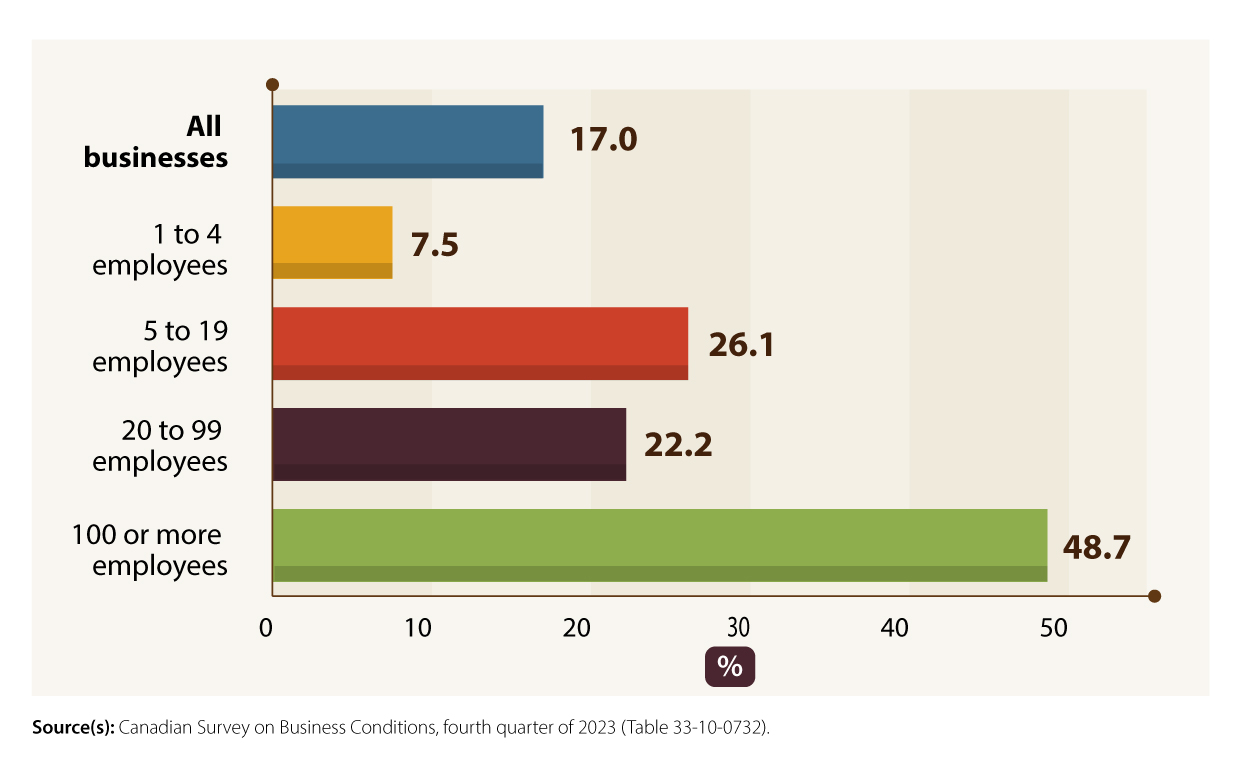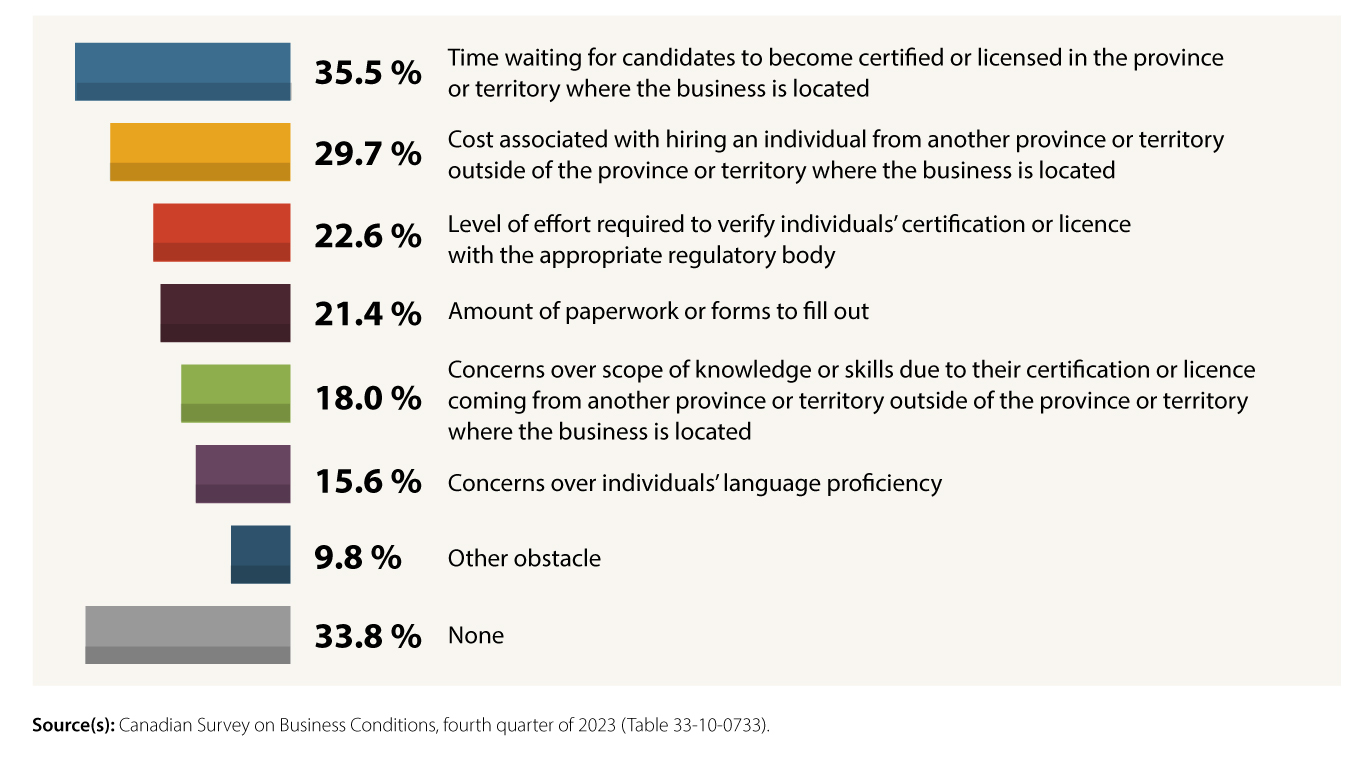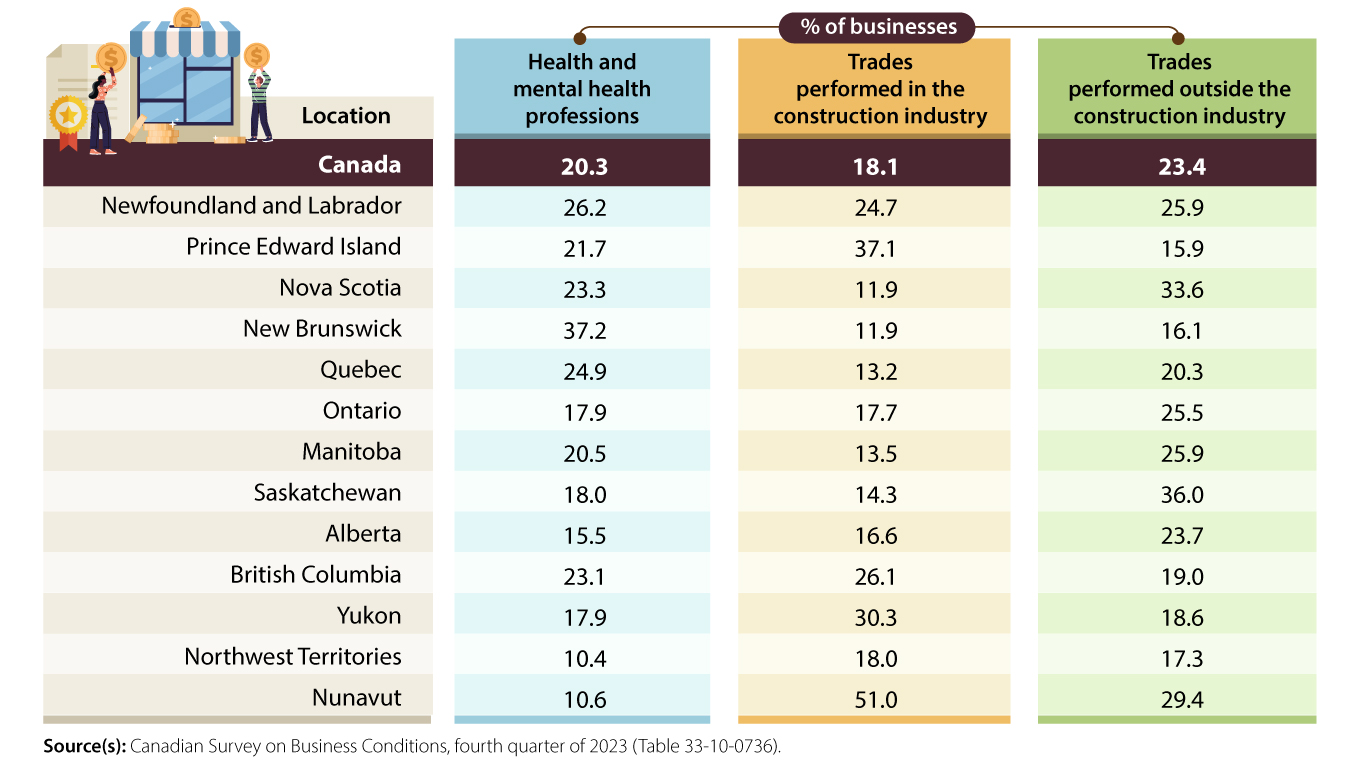
More than one in four businesses (28.0%) in Canada hired individuals in regulated occupations in the 12 months preceding the survey, according to the latest data from the Canadian Survey on Business Conditions for the fourth quarter of 2023. Of these businesses, 17.0% hired individuals with a professional certificate or industry licence from another province or territory across Canada in all industries. The remainder of this article presents findings on these businesses.
Businesses in the territories and large businesses most likely to hire individuals from other provinces
Of the businesses that hired individuals in regulated occupations in the previous 12 months, businesses located in the territories were the most likely to have hired or to have considered hiring individuals in regulated occupations from another province or territory.
Nearly two-thirds of those in Nunavut (64.9%) did so, followed by over half of businesses in the Northwest Territories (53.0%) and over one-third of those in Yukon (36.7%). Conversely, businesses in Manitoba (10.8%) and British Columbia (15.5%) were the least likely to do so.
Significant differences can be observed by industry, with businesses in mining, quarrying, oil and gas extraction (29.6%), manufacturing (26.6%), and health care and social assistance (26.1%) most likely to hire individuals in regulated occupations from another province or territory. Conversely, businesses in agriculture, forestry, fishing and hunting (7.2%), real estate and rental and leasing (7.4%), and construction (8.9%) were the least likely to do so.
Among businesses that hired individuals in regulated occupations, those with 100 or more employees were more likely to hire individuals in regulated occupations from another province or territory (48.7%). By comparison, 7.5% of businesses with 1 to 4 employees did the same.
Chart 1: Proportion of businesses employing individuals in regulated occupations that hired individuals with a professional certificate or industry license from another province or territory over the last 12 months, by business size, fourth quarter of 2023

Description - Chart 1: Proportion of businesses employing individuals in regulated occupations that hired or considered hiring individuals with a professional certificate or industry licence from another province or territory over the last 12 months, by business size,
This is a horizontal bar chart. The title of the chart is “Proportion of businesses employing individuals in regulated occupations that hired individuals with a professional certificate or industry license from another province or territory over the last 12 months, by business size, fourth quarter of 2023.”
The horizontal axis shows percentage. They are shown in increments of 10. They begin at 0 and go until 50.
The vertical axis shows the range of employees per business size. There are five bars in total.
There is one bar per employee range.
The first bar represents all businesses, at 17.0%.
The second bar represents businesses with 1 to 4 employees, at 7.5%.
The third bar represents businesses with 5 to 19 employees, at 26.1%.
The fourth bar represents businesses with 20 to 99 employees, at 22.2%.
The fifth bar represents businesses with 100 or more employees, at 48.7%.
Source(s): Canadian Survey on Business Conditions, fourth quarter of 2023 (table 33-10-0732).
Businesses report obstacles to hiring out of province or territory
Among businesses that hired or considered hiring individuals from another province or territory in regulated occupations, the most frequently reported obstacle was the waiting time for candidates to be certified or licensed in the businesses’ province or territory (35.5%). Businesses in health care and social assistance (56.9%) were the most likely to report this obstacle.
Nearly 3 in 10 businesses (29.7%) reported costs associated with hiring an individual from another province or territory as an obstacle. This obstacle was most commonly cited by businesses in retail trade (44.0%).
The level of effort required to verify a person's certification or license with the relevant regulatory body was reported as an obstacle by over one in five businesses (22.6%), with those in manufacturing (37.3%) most likely to report this obstacle.
Chart 2: Obstacles experienced by businesses when hiring or considering hiring individuals with a professional certificate or industry licence from another province or territory over the last 12 months, fourth quarter of 2023 (also see Note to readers below)

Description - Chart 2: Obstacles experienced by businesses when hiring or considering hiring individuals with a professional certificate or industry licence from another province or territory over the last 12 months, fourth quarter of 2023
This is a horizontal bar chart. The title of the chart is “Obstacles experienced by businesses when hiring or considering hiring individuals with a professional certificate or industry licence from another province or territory over the last 12 months, fourth quarter of 2023.”
The vertical axis shows the obstacles experienced by businesses. There are eight bars in total.
The first bar represents “Time waiting for candidates to become certified or licensed in the province or territory where the business is located”, at 35.5%.
The second bar represents “Cost associated with hiring an individual from another province or territory outside of the province or territory where the business is located”, at 29.7%.
The third bar represents “Level of effort required to verify individuals’ certification or licence with the appropriate regulatory body”, at 22.6%.
The fourth bar represents “Amount of paperwork or forms to fill out”, at 21.4%.
The fifth bar represents “Concerns over scope of knowledge or skills due to their certification or licence coming from another province or territory outside of the province or territory where the business is located”, at 18.0%.
The sixth bar represents “Concerns over individuals’ language proficiency”, at 15.6%.
The seventh bar represents “Other obstacle”, at 9.8%.
The eighth bar represents “None”, at 33.8%.
Source: Canadian Survey on Business Conditions, fourth quarter of 2023 (table 33-10-0733).
Difficulty hiring from another province or territory varies by occupational category
Businesses that reported hiring or considering hiring individuals from another province or territory in regulated occupations over the previous 12 months were then asked to indicate all occupational categories they hired or considered hiring individuals from.
Among these businesses, nearly one in four hired or considered hiring employees in trades performed outside the construction industry (23.4%) from another province or territory, compared with about one in five businesses hiring employees in health and mental health occupations (20.3%) and trades performed in the construction industry (18.1%).
Table 1: Proportion of businesses that experienced the most challenges when hiring individuals with a professional certification or industry license from another province or territory in select occupational categories by province and territory, fourth quarter of 2023 (also see Note to readers below)

Description - Table 1: Proportion of businesses that experienced the most challenges when hiring individuals with a professional certification or industry licence from another province or territory in select occupational categories by province and territory, fourth qua
The title of the table is “Proportion of businesses that experienced the most challenges when hiring individuals with a professional certification or industry licence from another province or territory in select occupational categories by province and territory, fourth quarter of 2023.”
This is a table. There are four columns and 15 rows. All numbers in the table are percentages, stated to one decimal place.
The first column is titled “Location” and lists Canada at the top, and the provinces in territories below it, in this order: Newfoundland and Labrador, Prince Edward Island, Nova Scotia, New Brunswick, Quebec, Ontario, Manitoba, Saskatchewan, Alberta, British Columbia, Yukon, Northwest Territories, Nunavut.
Each province and territory has a row, and each province and territory has three percentages, each one corresponding to a column, as titled below.
The second column is titled “Health and mental health professions”.
The third column is titled “Trades performed in the construction industry”.
The fourth column is titled “Trades performed outside the construction industry”.
The percentages for Canada are:
Health and mental health professions: 20.3%
Trades performed in the construction industry: 18.1%
Trades performed outside the construction industry: 23.4%
The percentages for Newfoundland and Labrador are:
Health and mental health professions: 26.2%
Trades performed in the construction industry: 24.7%
Trades performed outside the construction industry: 25.9%
The percentages for Prince Edward Island are:
Health and mental health professions: 21.7%
Trades performed in the construction industry: 37.1%
Trades performed outside the construction industry: 15.9%
The percentages for Nova Scotia are:
Health and mental health professions: 23.3%
Trades performed in the construction industry: 11.9%
Trades performed outside the construction industry: 33.6%
The percentages for New Brunswick are:
Health and mental health professions: 37.2%
Trades performed in the construction industry: 11.9%
Trades performed outside the construction industry: 16.1%
The percentages for Quebec are:
Health and mental health professions: 24.9%
Trades performed in the construction industry: 13.2%
Trades performed outside the construction industry: 20.3%
The percentages for Ontario are:
Health and mental health professions: 17.9%
Trades performed in the construction industry: 17.7%
Trades performed outside the construction industry: 25.5%
The percentages for Manitoba are:
Health and mental health professions: 20.5%
Trades performed in the construction industry: 13.5%
Trades performed outside the construction industry: 25.9%
The percentages for Saskatchewan are:
Health and mental health professions: 18.0%
Trades performed in the construction industry: 14.3%
Trades performed outside the construction industry: 36.0%
The percentages for Alberta are:
Health and mental health professions: 15.5%
Trades performed in the construction industry: 16.6%
Trades performed outside the construction industry: 23.7%
The percentages for British Columbia are:
Health and mental health professions: 23.1%
Trades performed in the construction industry: 26.1%
Trades performed outside the construction industry: 19.0%
The percentages for Yukon are:
Health and mental health professions: 17.9%
Trades performed in the construction industry: 30.3%
Trades performed outside the construction industry: 18.6%
The percentages for Northwest Territories are 10.4, 18.0, 17.3.
Health and mental health professions: 10.4%
Trades performed in the construction industry: 18.0%
Trades performed outside the construction industry: 17.3%
The percentages for Nunavut are:
Health and mental health professions: 10.6%
Trades performed in the construction industry: 51.0%
Trades performed outside the construction industry: 29.4%
Source: Canadian Survey on Business Conditions, fourth quarter of 2023 (Table 33-10-0736).
Measures taken by businesses to accommodate employees waiting on certification or license
Over half (56.4%) of businesses in Canada who hired individuals in regulated occupations from another province or territory only saw those individuals start working once their certification or license was recognized by the regulator for their occupation.
However, over one in four (29.6%) businesses indicated that they allowed a person to work under a limited scope of practice until they received their certification or license in the province or territory where the company is located.
Note to readers
A regulated occupation is a profession or skilled trade overseen by a provincial or territorial regulatory body.
Chart 2:
Respondents were asked if the business or organization employed individuals with a professional certification or a provincial or territorial or industry license regulated within the province or territory where the business is located over the 12 months preceding the survey. If they did, they were asked if they hired or considered hiring individuals with a professional certification or provincial or territorial or industry license from another province or territory outside of the province or territory where the business is located over the last 12 months. If they hired or considered hiring these individuals, they were asked which obstacles they experienced when doing so.
Table 1:
Respondents were asked if the business or organization employed individuals with a professional certification or a provincial or territorial or industry license regulated within the province or territory where the business is located over the last 12 months. If they did, they were asked if they hired or considered hiring individuals with a professional certification or provincial or territorial or industry license from another province or territory outside of the province or territory where the business is located over the last 12 months. If they hired or considered hiring these individuals, they were asked to specify the occupational categories in which the business or organization experienced the most challenges when hiring individuals with a professional certification or a provincial or territorial or industry license certified in another province or territory outside the province or territory where the business is located over the last 12 months.
Click here for more information on the Canadian Survey on Business Conditions.
StatsCAN app
Did you know you can read StatsCAN Plus articles and more on the StatsCAN app? If you’re already using the app, let us know what you think by leaving a review in the App Store and Google Play.
Contact information
For more information, contact the Statistical Information Service (toll-free 1-800-263-1136; 514-283-8300; infostats@statcan.gc.ca) or Media Relations (statcan.mediahotline-ligneinfomedias.statcan@statcan.gc.ca).
